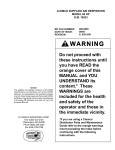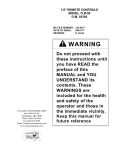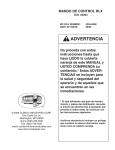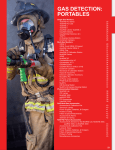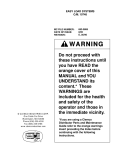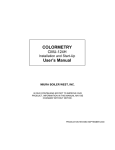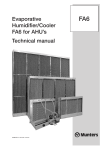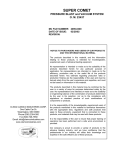Download Apollo 60 Specifications
Transcript
APOLLO 60 HP SUPPLIED-AIR RESPIRATOR CLEMCO SUPPLIED AIR RESPIRATOR MODEL 60 HP O.M. 10533 MC FILE NUMBER: DATE OF ISSUE: REVISION: 690-0985 09/85 P, 04/03 WARNING NOTICE This supplied air respirator conforms to all NIOSH specifications and standards and carries NIOSH approval. As manufactured, this respirator complies only with those foreign approvals that accept NIOSH certification. Specifically, it has not been manufactured to European CE standards and does not carry the European CE-mark. © CLEMCO INDUSTRIES CORP. One Cable Car Drive Washington, MO 63090 Phone (636) 239-4300 Fax (636) 239-0788 Email: [email protected] www.clemcoindustries.com ® Do not proceed with these instructions until you have READ the orange cover of this MANUAL and YOU UNDERSTAND its content.* These WARNINGS are included for the health and safety of the operator and those in the immediate vicinity. *If you are using a Clemco Distributor Parts and Maintenance Guide refer to the orange warnings insert preceding the Index before continuing with the following instructions. APOLLO 60 HP SUPPLIED-AIR RESPIRATOR Clemco Industries Corp. Washington MO, USA (636) 239-0300 TYPE C AND CE CONTINUOUS FLOW SUPPLIED-AIR RESPIRATOR IS APPROVED ONLY IN THE FOLLOWING CONFIGURATIONS: Respirator Components Black 1/2” x 50 Ft. 22510 x x x x x x x Cautions and Limitations 2 Yellow -100 Ft. Black 1/2" x 100 Ft. 21413 Yellow -50 Ft. 04398 04415 x x ACV-II Yellow -25 Ft. 04397 x x x x x x x x x CFC/Low Pressure 21777 CCT CFC/High Pressure 04411 21422 x x ACV CAT 04410 x Apollo 20 04440 21302 x x x Apollo 60 Model Part No. 10506 x CF/SA CF/SA CF/SA CF/SA x 1 Protection TC# 19C-338 19C-339 19C-130 19C-358 1.1.3 The NIOSH approval number for this respirator is TC-19C-130. The NIOSH label shown on this page lists all Apollo respirator approval numbers. An X on the approval line indicates which components are approved for the specific respirator. Do not use any non-approved components with this respirator. Hose Air Line 100024 Alternate Regulators Helmets BCDEJMNOS BCDEJMNOS BCDEJMNOS BCDEJMNOS 1 PROTECTION CF - Continuous Flow SA - Supplied -air 2 CAUTIONS AND LIMITATIONS B- Not for use in atmospheres immediately dangerous to life or health. C- Do not exceed maximum use concentrations established by regulatory standards. D- Air-line respirators can be used only when the respirators are supplied with respirable air meeting the requirements of CGA G-7.1 Grade D or higher quality. E- Use only the pressure ranges and hose lengths specified in the user's instructions. J- Failure to properly use and maintain this product could result in injury or death. M- All approved respirators shall be selected, fitted, used, and maintained in accordance with MSHA, OSHA, and other applicable regulations. N- Never substitute, modify, add, or omit parts. Use only exact replacement parts in the configuration as specified by the manufacturer. O- Refer to users instructions, and/or maintenance manuals for information on use and maintenance of these respirators. S-Special or critical users instructions, and/or specific use limitations apply. Refer to instruction manual before donning. 1.1.4 For safe use of the respirator, it is essential that the user be properly instructed in its use and maintenance. This manual must be made available to all users of the respirator. [Reference OSHA Regulations 1910.134.] Read the entire manual before installing or operating the equipment. 1.1.5 The respirator must be supplied with respirable air meeting requirements described herein. It is the responsibility of the owner to provide quality breathing-air to the respirator, and to establish a program to ensure that the respirator is properly used and maintained. 1.1.6 The following manuals are available for accessories that may be used in conjunction with the Apollo Respirator. Description CAT Cool-Air Tube CCT Climate Control Tube CPF Particulate Air Filter 1.2 1.0 INTRODUCTION 1.1 Scope of manual Page 1 1.1.1 This manual covers setup, operation, maintenance, replacement parts, and important warnings for safe operation of the Clemco Apollo 60 HP Supplied-Air Respirator. 1.1.2 OSHA requires the employer to establish a comprehensive respiratory protection program per regulations 29 CFR 1910.134(a)(b) and 29 CFR 1926.103, to include the following: 1. Program coordination by a designated responsible individual. 2. Evaluation of each worker’s ability to perform the work while wearing a respirator. 3. Periodic training. 4. Periodic environmental monitoring. 5. Respirator-fit testing. 6. Maintenance, inspection cleaning, and storage of the respirators. 7. Selection of the proper NIOSH-approved respirator. Manual No. 08956 08850 04143 Safety Alerts 1.2.1 Clemco uses safety alert signal words, based on ANSI Z535.4-1998, to alert the user of a potentially hazardous situation that may be encountered while operating this equipment. ANSI’s definitions of the signal words are as follows: This is the safety alert symbol. It is used to alert the user of this equipment of potential personal injury hazards. Obey all safety messages that follow this symbol to avoid possible injury or death. CAUTION “Caution” used without the safety alert symbol indicates a potentially hazardous situation which, if not avoided, may result in property damage. APOLLO 60 HP SUPPLIED-AIR RESPIRATOR CAUTION “Caution” used with the safety alert symbol indicates a potentially hazardous situation which, if not avoided, may result in minor or moderate injury. WARNING “Warning” is used to indicate a potentially hazardous situation which, if not avoided, could result in death or serious injury. DANGER “Danger” is used to indicate an imminently hazardous situation which, if not avoided, will result in death or serious injury. 1.3 Respiratory and Health Alerts WARNING TOXIC DUST POISONING Research by the Occupational Safety and Health Administration (OSHA) has discovered potential risks of lead and other heavy metal poisoning to unprotected abrasive blasting operators and other personnel who may be exposed to toxic dust in the abrasive blasting vicinity. Toxic dust is produced primarily by the removal and breakdown of lead or other heavy metal coatings during abrasive blasting. The breakdown of toxic coatings and hazardous abrasive causes the contaminants to become airborne. Breathing toxic dust from lead or other heavy metal coatings may cause health and life threatening toxic poisoning and can damage vital organs. Breathing hazardous dust produced from silica abrasive may cause delayed life threatening respiratory disease such as silicosis. Lead is one of several toxic dusts that may be present in an abrasive blasting operation. It is imperative that blasting contractors identify all material being removed by blasting, and obtain material safety data sheets (MSDS) for the blasting abrasive prior to blasting. It is the responsibility of the employer to identify all airborne con- Page 2 taminants in the blast vicinity, and ensure they do not exceed the permissible exposure limit (PEL) Ref. 29 CFR 1910.1000 and 29 CFR 1926.62. Thorough examinations should be made by an industrial hygienist or other qualified professional to identify all contaminants generated by blasting and in the blasting vicinity. Exposure to dangerous levels of lead or other toxic or hazardous dust is not restricted to blast operators. There may be an equal or greater danger after the blasting process due to lingering airborne dust particles, and especially from dust generated during cleanup activity. Heavy metal paint, asbestos, sand or other silica, and other toxic material dusts will cause serious lung disease or death without the use of properly designed, and maintained NIOSH-approved, supplied-air respirator equipment by blasting operators and all personnel within the work site area. Lead poisoning can cause death. OSHA has stated that the permissible exposure limit of lead is 50 micrograms per cubic meter of air (50 µg/m3), averaged over an 8-hour workday. The Apollo supplied-air respirator system is approved by NIOSH as a Type-CE, continuous-flow, abrasive blast, supplied-air respirator, in accordance with title 42 CFR Part 84. The NIOSH recognized assigned protection factor (APF) for any supplied-air respirator equipped with a loosefitting hood or helmet and operated in a continuous flow mode is 25, based upon the NIOSH Respirator Decision Logic (Pub. No. 87-108). In other words, any Type-CE respirator should be used only in atmospheres in which the contaminant level does not exceed 25 times the permissible exposure limit. However, in its Memorandum for Regional Administrators dated August 30, 1995, OSHA has stated that select individual Type-CE continuous-flow, abrasive blast, supplied-air respirator models that pass stringent tests conducted by independent third party testing laboratories will be granted APF values higher than the NIOSH recognized 25. Clemco contracted with Los Alamos National Laboratory to conduct the independent testing. Based upon the results of these tests, OSHA will treat the Apollo Supplied-Air Respirator (NIOSH Approval TC-19C130) as having an APF of 1000 times the permissible exposure limit, or 50,000 µg/m3 when used in lead removal applications. The employer must provide and maintain appropriate approved respirators, in addition to providing operator training and employing required work site safety practices. To avoid any potential danger of respiratory injury, approved, supplied-air respirators must be worn at all times in the presence of any type of dust. The respirator must be maintained as described herein. Improper use of any respirator may cause life threatening respiratory disease, and immediate poisoning from toxic dust. Respirators should be removed only after the ambient air has been tested with a dust monitor, and found to be safe to breathe. APOLLO 60 HP SUPPLIED-AIR RESPIRATOR Toxic dust poisoning may also occur by eating, drinking, or smoking in a contaminated area, or by eating, drinking, or smoking in a non-hazardous area before thorough washing of hands and face. Do not eat, drink or smoke in the blast area. Thoroughly wash hands and face to remove contaminants before eating, drinking, or smoking outside the blast area. This manual does not contain all the health and safety requirements regarding toxic and hazardous dust exposure. Obtain copies of the OSHA regulations and consult a safety professional and/or industrial hygienist for complete requirements. Within this manual we refer to hazardous or contaminated environments. These environments can be any place around the blast area that could contain toxic or hazardous dust. If these warnings are not completely understood, or if further information is required, contact a local OSHA office. If any personnel in the abrasive blasting vicinity cannot read or comprehend these warnings and the entire content of this instructional material, assign a qualified person to instruct him/her. Additional information on abrasive blasting hazards titled “Preventing Silicosis and Death From Sandblasting”, Publication No. 92-102, is available from: Publications Dissemination, DSDTT National Institute for Occupational Safety and Health Page 3 1.4.8 Refer to users instructions, and/or maintenance manuals for information on use and maintenance of these respirators. 1.4.9 Special or critical users instructions, and/or specific use limitations apply. Refer to instruction manual before donning. 1.5 S-Special or Critical User's Instructions 1.5.1 Air pressure at the point of attachment (the point of attachment is where the respirator supply hose is connected to the respirable air source) must be maintained at pressures between the minimum pressure as shown in the table in Section 4.2.4 and the maximum of 100 psi. WARNING Failure to maintain the minimum pressure at the point of attachment may reduce air flow below the minimum flow required by OSHA. Reduced air flow may result in ingress of hazardous toxic dust, subjecting the user to immediate health and life threatening poisoning and subsequent respiratory disease. 4676 Columbia Parkway Cincinnati, OH 45226 1.4 (513) 533-8287 Cautions and Limitations 1.4.1 Not for use in atmospheres immediately dangerous to life or health. 1.4.2 Do not exceed maximum use concentrations established by regulatory standards. 1.5.2 Use no more than 12 sections of respirator hose to obtain a total maximum length of up to 300 feet, as noted in the table in Section 4.2.4. 1.5.3 The respirator is designed for specific use in abrasive blasting applications. Do not use in other operations such as painting or welding. 1.6 1.4.3 Air-line respirators can be used only when the respirators are supplied with respirable air meeting the requirements of CGA G-7.1 for Grade D or higher quality. 1.4.4 Use only the pressure ranges and hose lengths specified in the instruction manual. 1.4.5 Failure to properly use and maintain this product could result in injury or death. 1.4.6 All approved respirators shall be selected, fitted, used, and maintained in accordance with MSHA, OSHA, and other applicable regulations. 1.4.7 Never substitute, modify, add, or omit parts. Use only exact replacement parts in the configuration as specified by the manufacturer. Protection 1.6.1 Assigned Protection Factor (APF): The NIOSH recognized assigned protection factor for any Type-CE respirator (the Apollo respirator is a Type-CE respirator) is 25 times the permissible exposure limit (PEL). In other words, CE respirators should be used only in atmospheres in which the contaminant level does not exceed 25 times the PEL. However, based upon the results of independent testing, OSHA will treat the Apollo Supplied-Air Respirator as having an APF of 1000 times the PEL when used in lead removal applications. 1.6.2 Head: The respirator protects the wearer’s head and neck from impact and from abrasion caused by rebounding abrasive. The respirator meets physical requirements for industrial head protection as stated in ANSI APOLLO 60 HP SUPPLIED-AIR RESPIRATOR Z89.1-1997 as a Type I Class G protective helmet. 1.6.3 Face and Eye: The Apollo 60 inner lens meets impact and penetration requirements under ANSI Z87.11989. 1.6.4 Hearing: Noise generated by the Apollo respirator and measured inside the helmet do not exceed 80 decibels. (42 CFR part 84.140) When any exterior noise causes the internal noise level to exceed 80 decibels, the user must wear additional hearing protection. A variety of hearing protectors can be worn with the respirator. 1.7 Description 1.7.1 The Clemco Apollo 60 Supplied-Air Respirator is approved by the National Institute of Occupational Safety and Health (NIOSH). Page 4 WARNING OSHA/NIOSH approval applies only when this supplied-air respirator is used as a complete system. Do not make any non-approved modification, deletion, or substitution. Non-approved components voids the NIOSH approval and may permit ingress of toxic and hazardous dust, and result in toxic poisoning and respiratory disease. 1.7.2 The respirator comes with one of four air control devices that permit safe, comfortable blast cleaning under various conditions. • Constant-Flow Connector (CFC): Provides non-adjustable volume of supplied air, within the cfm range required by OSHA. • Air Control Valve (ACV or ACVII): Enables the user to adjust the volume of supplied air, within the cfm range required by OSHA. It is for use in areas where the air temperature is comfortable. Apollo 60 Supplied-Air Respirator Breathing-Air Tube Assembly CMS-2 Carbon Monoxide Monitor General Arrangement of Operator Safety and Comfort Components Blast Suit Gloves Air Control Device Breathing-Air Source Respirator Supply Hose CPF-20 Particulate Filter Figure 1. APOLLO 60 HP SUPPLIED-AIR RESPIRATOR • Cool-Air Tube (CAT): Used in warm climates to enable the user to adjust supplied air to cooler temperatures. • Climate Control Tube (CCT): Enables the user to adjust supplied air to warmer or cooler temperatures. 1.7.3 Low Pressure Conversion Kit: This optional accessory kit contains parts and instructions to convert the Apollo 60 HP, (respirator for use with Grade “D” Compressed Air) to Apollo 60 LP (respirator for use with ambient air pump). The kit is listed in Section 10.1. 2.0 INSPECTION NOTE: A Clemco respirator hose must be used with the Apollo Respirator. If one is not available, it must be ordered from an authorized distributor of Clemco products. Hoses are not included with respirators, because blast operators often are assigned personal respirators, while using common respirator hoses. 2.1 Component Checklist 2.1.1 Make sure that all the respirator components are present. Each respirator box should contain the following: • Helmet with chin strap, suspension and cape attached • Breathing tube assembly • One of the following air control devices with belt: Constant-Flow Connector Air Control Valve Cool-Air Tube Climate-Control Tube • Disconnect and male adaptor NOTE: Respirator hose (one or more alternate hoses) must be ordered separately. 2.1.2 When all of these components are present, prepare the respirator for operation per Section 3.0. 3.0 PREPARATION 3.1 Adjust Helmet Suspension per Section 6.2. 3.2 Lens Assembly Page 5 WARNING Never use the respirator without the fixed inner lens and perforated outer lenses in place. The fixed lens provides support for the window gasket. If the gasket is not adequately supported, leaks can occur which could permit entry of toxic and hazardous dust or abrasive into the helmet. 3.2.1 The lens system is an important part of the respirator assembly. The helmet is supplied with an inner lens, secured by a thick rubber gasket. Held in place on top of the inner lens by the window frame are up to five perforated outer lenses. 3.2.2 9.1) Check that the inner lens is in place. (See Section 3.2.3 The perforated outer lenses are secured to the helmet by the window frame. As one lens becomes frosted during blasting, it can be torn off to expose the next lens. Check that the perforated outer lenses are in place. (See Section 9.2) 3.3 Belt 3.3.1 Using the spring clip attached to the ConstantFlow Connector, attach the connector to the belt slide. This step is not required with alternate air control devices, because the Air Control Valve is furnished with a belt loop, and belts are attached to Cool Air Tubes and Climate Control Tubes. 3.4 Breathing Tube Assembly WARNING Note the directional flow arrows on the labels at both ends of the breathing tube. The flow arrows indicate the direction of air flow to the helmet. Flow arrows should point toward the helmet. Failure to properly attach the breathing tube may damage the tube's acoustical foam, which will block air flow, or it may increase noise levels beyond OSHA limits. 3.4.1 Attach the clamped-on end of the breathing tube to the threaded air inlet fitting at the back of the helmet as shown in Figure 2. Do not over-tighten; hand-tight is sufficient. APOLLO 60 HP SUPPLIED-AIR RESPIRATOR Connect the molded-on swivel to the constant flow connector or optional air control device. Use the strap to carry and hang the respirator. Do not carry or hang the respirator by the breathing tube. Connect the clamp-on swivel to the respirator. Breathing Tube 4.0 Page 6 AIR SUPPLY WARNING Air supplied to this respirator system is critical to the safety of the user. Read this section carefully. Poor quality air will cause serious respiratory injury or death to the user. See Toxic Dust Poisoning Warning in Section 1.3. Figure 2. 4.1 3.4.2 Attach the molded-on swivel connector to the Constant-Flow Connector, or the alternate air control device 3.4.3 Use the strap handle to carry or hang the respirator. Never hold, carry or hang the respirator by the breathing tube. Mishandling the respirator in this manner may damage the tube or helmet inlet. Any leaks or breaks in the breathing tube will alter the air flow through the respirator and affect user’s safety and comfort. 3.5 Respirator Hose 3.5.1 Apply teflon tape to the 1/4" male threads on the 3/8" hose to 1/4" pipe adaptor, and connect it wrench-tight to the female disconnect. 3.5.2 OSHA regulation 29 CFR1910 and 29 CFR 1926 require that respirator air line couplers be incompatible with air lines for nonrespirable use. This incompatibility prevents inadvertent servicing of respirators with nonrespirable gases or oxygen. It is the employer's or facility owner's responsibility to comply with the regulation. 3.5.3 Use the disconnect adaptor (coupler) assembly to attach the respirator hose to the Constant-Flow Connector, or alternate air control device. Using the adaptor provided, connect the other end of the respirator hose to a respirable air source. If longer hose is required, it must be a NIOSH-approved Clemco respirator hose extension. Any 25 foot, 50 foot and 100 foot respirator hoses can be added in any combination to produce the maximum total length as noted in the table in Section 4.2.4. Air Quality 4.1.1 The quality of air supplied to the respirator is extremely critical to the safety of the user. Special care must also be taken to avoid accidental connection to any other gas lines; such as, oxygen, acetylene, or nitrogen. WARNING Never connect a breathing air line to an air source that has not been tested for gas and particulate contamination. The presence of unacceptable levels of carbon monoxide (CO) or other gases in the breathing air will cause death to the user. WARNING Do not use piston type, oil-bath, compressors for breathing air. These compressors could produce dangerous levels of carbon monoxide, which will cause death to the user. 4.1.2 Breathing air used to supply the respirator must be respirable breathing air and contain no less than 19.5 volume-percent of oxygen. Breathing air shall also meet the requirements for Grade D or higher quality, as described in Compressed Gas Association Commodity Specification pamphlet G-7.1., titled Commodity Specification For Air, published by Compressed Gas Association Inc., Chantilly, VA. (42 CFR Chapter 1). 4.1.3 Prior to using the respirator, read the owner’s manual and all instructions, labels, and warnings relating APOLLO 60 HP SUPPLIED-AIR RESPIRATOR to the compressed air source. Take special care to abide by all warnings from the compressor manufacturer regarding compressor use. 4.1.4 A breathing air type compressor must be used. The compressor must be equipped with necessary safety and monitoring devices, plus suitable in-line air filters and purifying equipment to assure breathing air quality. [Reference OSHA Regulations 29 CFR 1910.134 (d), and 29 CFR 1926.103 (f)]. 4.1.5 If an oil-lubricated compressor is used, it must be equipped with a high-temperature alarm or carbon monoxide (CO) alarm, or both. If only a high-temperature alarm is used, the air from the compressor must be tested frequently for the presence of carbon monoxide. [Reference OSHA Regulations 29 CFR 1910.134 (d) and 29 CFR 1926.103 (f)]. 4.1.6 Regardless of the air compressor type, precautions must be taken to prevent contaminants from entering through the compressor intake. The compressor inlet must be located away from all sources of toxic contaminants including carbon monoxide, which is found in engine exhaust, and in any form of combustion. No vehicles should be allowed near the compressor intake. Contaminants can enter respiratory equipment through the compressor air inlet. This inlet must not be located near any exhaust system outlet, ventilation flue, or source of fumes or particles of any kind. 4.1.7 The precautions described above also apply to portable compressors. In addition, in the case of enginedriven compressors, precautions must be taken to prevent engine exhaust gases from entering the air intake of the compressor. Compressor engine exhaust should be piped to a location safely downwind from the compressor air intake. Compressors vary in design and operation; therefore, it is important that users carefully read the manufacturer’s operation and maintenance instructions before making modifications. 4.1.8 An appropriate air filter must be installed and regularly maintained to remove objectionable odors, as well as oil mist, water, pipe scale and other particulate matter. Refer to OSHA Regulation 1910.94(6). The Clemco CPF Air Filter complies with the regulation, and provides the pressure reducing valve referred to in the regulation. 4.1.9 It is the owner’s and user’s responsibility to check the air supply. This includes the compressor, carbon monoxide alarms, air filters, and shut-down devices. An overheated compressor, or one that is in poor mechanical condition, may produce carbon monoxide. A carbon monoxide removal or conversion system may also be used to ensure breathing air quality. The maximum allowable presence of carbon monoxide in Grade D breathing air is Page 7 10 parts per million (ppm). 4.2 Air Volume and Pressure 4.2.1 A pressure regulator and gauge must be installed at the point where the respirator hose is attached to the air source. The Clemco CPF Filter with regulator meets this requirement if the inlet pressure does not exceed 125 psi. See typical installation, Figure 1. DANGER Do not connect the Apollo Respirator or CPF Filter, or any other regulator or filter, to bottled air that does not have a pressure reducing valve that reduces pressure to maximum of 125 psi (65 to 100 psi for the respirator only). Failure to comply with this warning will cause devices rated at lower pressures to explode under the high pressure of bottled air. Such an explosion could cause severe injury or death. 4.2.2 The respirator must be supplied with 15 cfm (cubic feet per minute) of Grade D breathing air at 65 to 100 psi (pounds per square inch). When using an alternate CoolAir Tube or Climate Control Tube, the respirator must be supplied with 20 cfm of Grade D breathing air at 90 to 100 psi. 4.2.3 The pressure regulator must be adjusted to 65 to 100 psi. Refer to the table in Section 4.2.4 to determine the minimum pressure, based on the total length of respirator hose, and choice of air control device. Adjust the pressure with the respirator hose and respirator attached. If the regulator is adjusted with static pressure (no air flow), pressure may drop below the required pressure when the respirator is connected, and may result in low air flow. Setting the pressure as instructed will provide a minimum of 7 cfm to the respirator. APOLLO 60 HP SUPPLIED-AIR RESPIRATOR 4.2.4 Use the table below to determine the minimum pressure setting and maximum respirator hose length, based on the air control device as shown in Section 1.7.2. Hose Minimum Pressure Setting, psi ACV& Length CFC ACVII CCT CAT 25 ft. 65 85 90 90 50 ft. 65 85 90 90 75 ft. 65 85 90 90 100 ft. 65 85 95 95 125 ft. 70 90 95 95 150 ft. 70 90 100 100 175 ft. 70 90 100 100 200 ft. 70 90 100 100 225 ft. 75 95 * * 250 ft. 75 95 * * 275 ft. 75 95 * * 300 ft. 75 95 * * * Do not use these control devices at distances greater than 200 ft. WARNING The compressor must provide adequate output, and the plumbing between the compressor and the point of attaching the respirator hose must have sufficient capacity to supply the volume of air at the pressure required (as stated in Section 4.2.2). Restricted air flow will cause discomfort to the user, and may result in ingress of hazardous and toxic dust, subjecting the user to health and life threatening toxic poisoning and long term respiratory disease and death. 5.0 Page 8 OPERATION WARNING With the respirator on, leave the blast area immediately if any of the following conditions occur: • Any part of the respirator system becomes damaged. • Any air monitoring alarm is activated. • Airflow into the respirator is reduced or stops. • Breathing becomes difficult. • At the first sign of dizziness, nausea, fever, illness or injury. • Any contamination is noted by taste, smell or vision inside the respirator. • Vision becomes impaired. • Any irritation is noted. 5.1 Prior to operation, thoroughly inspect and clean the helmet, breathing tube, respirator hose, air entry ports, and fittings of all dust and debris. Inspect the helmet suspension and adjust if necessary per Section 6.2. 5.2 Start the compressor and open the service valve to pressurize the air supply line. 5.3 Check air pressure at the point of attachment. Set the pressure between the minimum pressure assigned in Section 4.2.4 and the maximum of 100 psi. Pressure must be set with the respirator connected. 5.4 Check all safety, and breathing equipment used in conjunction with the respirator as recommended by the manufacturer. 5.5 Check respirator hoses and connections for tightness and leaks. 5.6 Put the respirator on in a clean non-hazardous environment, free of contaminants, where the air is safe to breathe. When putting the respirator on or taking it off, keep it upright to prevent dust and abrasive from falling inside. 5.7 Position the chin strap so it fits comfortably under the chin. 5.8 Position the knit cuff on the inner collar so that it fits snugly around the neck in turtleneck fashion, without any interference from clothing such as shirt collars. When correctly positioned the smaller elastic end of the collar must face up. APOLLO 60 HP SUPPLIED-AIR RESPIRATOR Page 9 WARNING Correct placement of the inner collar is critical for providing the protection for which the respirator is designed. The collar must be positioned and maintained without any interference from items such as hair, facial hair, or shirt collars, between the collar and user’s neck. Increase Air Flow 5.9 Pull the cape down to fully extend it and connect the four elastic straps (two on each side) under the arms, and tighten using the slides provided. 5.10 Put the belt and control valve on over the cape. Buckle the belt around the waist, and tighten it by pulling the belt end through the buckle insert. 5.11 When finished blasting and with cleanup, remove the respirator in a clean, non-hazardous environment where the air is safe to breathe. WARNING Do not put the respirator on, or store it in a blast contaminated environment. Do not remove the respirator in a contaminated environment except for emergency evacuation when the use of the respirator hinders escape. 6.0 ADJUSTMENTS 6.1 Air Control Valve, alternate, Figure 3a & 3b. Belt Loop Pull sleeve down and turn to adjust air flow Higher Adjustment sleeve Lower Inlet End (bottom of unit) ACV Figure 3a. Control Knob Decrease Air Flow ACV-II Figure 3b 6.1.1 Clemco’s Air Control Valves allow the user to increase or decrease the volume of breathing-air while wearing the supplied-air respirator. The valves provide a range of 7 to 10 cfm of breathing-air when it is supplied with respirable air as noted in Section 4.0. 6.1.2 ACV: To regulate the air flow, pull down and turn the large sleeve on the lower end of the valve in the desired direction to increase or decrease the air flow as needed. A soft hissing sound is normal when the air control valve is in operation as some air is allowed to escape underneath the sleeve to prevent the entry of dust into the adjustment mechanism. 6.1.3 ACV-II: To regulate the air flow, turn the control knob "clockwise" to decrease air flow, or "counterclockwise" to increase air flow. When the knob is turned fully clockwise to minimum flow, maximum flow is obtained within the first full counterclockwise revolution of the knob. Turning the knob more than one revolution counterclockwise does not increase air flow. APOLLO 60 HP SUPPLIED-AIR RESPIRATOR 6.2 Helmet Suspension Adjustment and Replacement, Figure 4 Suspension Strap White Plastic Tabs (rear) Page 10 suspension. Insert the yellow end tabs into the clefts on the helmet shell. When correctly installed, the strap is between the suspension and helmet shell and above the ears. 6.2.7 Install the suspension by inserting the four white plastic tabs into the clefts on the shell. The tabs must fully seat in their respective locators. Button A Vinyl Sweatband White Plastic Tab (front) Headband Size Slots Front Band Lugs Front Holder Head Band Tongue Button B Figure 4. WARNING The suspension maintains a fixed distance between the head and the helmet. It is critical that the suspension is properly installed, and adjusted as described, to provide maximum head protection and comfort. 6.2.1 Remove the cape from the helmet per Section 9.4. 6.2.2 Remove and discard the old suspension and suspension strap by extracting the plastic tabs from the wedge-shaped clefts in the shell. 6.2.3 Unfasten the vinyl sweatband from the two lower, outside buttons (A and B in Figure 4). 6.2.4 The suspension fits head sizes 6.5 to 8. Head sizes are marked on the headband slots. Slide the headband tongue through the front holder until the desired head size is reached. It is important that the adjustment be made evenly on both sides. Press the selected slots firmly onto the lugs on the front band. 6.2.5 Fasten the vinyl sweatband onto the buttons of the suspension. 6.2.6 Install the suspension strap before installing the 6.2.8 Try the helmet on for fit and readjust if necessary. It is not necessary to remove the suspension to make adjustments. 6.2.9 Check that the chin strap is in place, then reattach the cape onto the helmet following the instructions in Section 9.4. 7.0 MAINTENANCE PROGRAM 7.1 Basic Service 7.1.1 A program for maintenance and care of the respirator must be established based on application, working conditions, and hazards involved, and include the following basic service. • Inspection for defects (including a leak check) • Cleaning and disinfecting • Repair (service maintenance) • Storage Equipment must be properly maintained to retain its original effectiveness. [Reference OSHA Regulations 1910.134 (f)]. 7.2 Inspection 7.2.1 Inspect respirators before and after each use. Inspection shall include a check for tightness of connections and the condition of the lenses, suspension, cape and elastic parts, breathing tube, respirator hoses and connectors, Constant-Flow Connector or alternate air control valve or temperature control valve. [Reference OSHA Regulations 1910.134 (f)(2)]. 7.2.2 The respirator hoses, breathing tube, air entry ports, and fittings must be checked for dust contamination, and cleaned before making connections. 7.2.3 The helmet suspension is a very important component for maintaining maximum hard hat and respiratory protection. It must be inspected for fit and wear on a daily basis, and replaced immediately at the first sign of wear. (See Section 6.2) 7.2.4 The inner collar is a very important factor in APOLLO 60 HP SUPPLIED-AIR RESPIRATOR controlling air escape from the helmet and preventing ingress of dust. The elastic properties of the collar are intended to provide a snug fit on the user’s neck. The collar must be replaced before it is stretched to the point where it no longer fits snugly around the neck. 7.2.5 The outer cape provides protection from rebounding abrasive and from abrasive ingress into the helmet. Inspect the outer cape frequently for wear. Replace the cape before holes are worn through, or any wear occurs that prevents the cape from providing the protection for which it is intended. 7.3 Cleaning and Disinfecting 7.3.1 Respirators must be cleaned and disinfected as frequently as necessary to ensure that proper protection is provided to the wearer. Respirators used by more than one person must be cleaned and disinfected after each use. See Section 8.0 for cleaning instructions. [Reference OSHA Regulations 1910.134 (b)(5); 1910.134 (f)(3)]. 7.4 Repair (Service Maintenance) Page 11 CAUTION Follow washing instructions as described in this section. Do not use any caustic chemicals or solvents that may be irritating or harmful to the user, or which change the properties of the materials used in any part of the respirator. 8.1 Outer Cape 8.1.1 The cape can be machine washed using warm water and mild detergent. Dry in a clothes dryer at the lowest temperature setting. Do not dry clean. See Section 9.4 for removal and installation instructions. 8.2 Inner Collar 8.2.1 The removable inner collar should be frequently washed to remove build-up of dirt that accumulates from normal perspiration and air moisture. For general hygiene, daily washing is recommended. 7.4.1 Replacement or repairs shall be done only by trained persons, using genuine Clemco parts designed for the respirator. No attempt shall be made to replace components or to make adjustment or repairs beyond the manufacturer’s recommendations. See Sec. 9.0 for service instructions. [Reference OSHA Regulations 1910.134 (f)(4)]. 8.2.2 The inner collar may be either washed or replaced separately or with the outer cape. To wash separately, unzip the collar and machine wash with warm water and mild detergent. Tumble dry in a clothes dryer at the lowest temperature setting. Do not dry clean. 7.5 Storage 7.5.1 Daily Storage 8.3.1 The sweatband, suspension, suspension strap, and chin strap should be washed using warm water and mild detergent. See Section 6.2 for removing the suspension. 7.5.1.1 When the respirator is not in use, it must be stored in a clean, dry area. Hang the respirator by the strap provided on the top. Do not tuck the cape inside the helmet. Let the cape hang loose to allow air to circulate, to dry condensation from the cape and from inside the helmet. 7.5.2 Long-term Storage 7.5.2.1 After inspection, cleaning and thorough drying, and after necessary repairs are made, the cape should be tucked inside the helmet. The respirator shall then be placed in a plastic bag and the bag sealed to keep out dust and moisture. Place the bag in a clearly marked carton and store it in a clean, dry place. [Reference OSHA Regulations 1910.134 (f)(5)]. 8.0 CLEANING 8.3 8.4 Sweatband and Suspension Helmet Assembly 8.4.1 The helmet assembly should be wiped clean with mild detergent and water. DO NOT IMMERSE THE HELMET IN WATER! While this does not permanently damage the helmet, it will require an extended drying period. 8.4.2 Care must be used to prevent abrasive entry when putting on or removing the respirator and when changing lenses. Vacuum the inside of the helmet to remove any abrasive. 8.4.3 If the acoustical foam on the inside of the helmet becomes soiled, it can be wiped with a damp cloth or pulled off and replaced. Page 12 APOLLO 60 HP SUPPLIED-AIR RESPIRATOR 8.5 Inner Lens 8.5.1 Inner lenses should be replaced when dirty or scratched; however mild detergent and water can be used to clean the inner lens. Volatile solutions such as alcohol, gasoline or ammonia must not be used to clean this lens. Allow the lens to air dry; cloth and towels can scratch the lens surface. 9.0 Perforated Outer Lens Lens Pull Tab Window Frame Locating Tabs Inner Lens SERVICE MAINTENANCE Hinge Inner Lens Gasket CAUTION Lens Replacement Figure 5. Clean the respirator of dust and media before maintenance. All maintenance must be done in a clean environment away from dust and media. Doing so will help prevent ingress of dust and contaminants. 9.1 Replacing Inner Lens 9.1.1 Unlatch and open the window frame. 9.1.2 Working from inside the helmet, pull up the window gasket lip and push the gasket and lens out the front of the window opening. 9.1.3 Remove the old lens from the gasket and replace with new lens. 9.1.4 Place the new lens and gasket over the window opening. From the inside of the helmet, work the gasket lip back onto the helmet. 9.1.5 Smooth out wrinkles in the gasket on the inside of the helmet. 9.1.6 To maximize the wear life of the inner lens do not remove the last perforated outer lens. (See Section 9.2) The respirator must never be used without the inner lens in place. 9.2 Replacing Perforated Outer Lenses, Figure 5 9.2.1 Up to five outer lenses can be installed at one time. For maximum visibility, install only enough lenses to last during a work period. 9.2.2 Preparing lenses in the following manner will permit lenses to be pulled off easily by a user wearing heavy gloves. 9.2.3 Place up to five lenses on a clean flat surface. Fold up the tab of each lens except the first and last, so that the tab of each lens is against the back of the one over it. 9.2.4 Unlatch and open the window frame and remove all remnants of old lenses. 9.2.5 Pick up the stack of prepared lenses. They will be installed with the straight side toward the top of the helmet, and the pull tabs toward the hinged end of the window frame. See Figure 5. 9.2.6 Drop only the top lens tab through the window frame opening at the window frame hinge end. The tab of the bottom lens (inside lens) should not go through the window frame opening. Placing the lenses in this manner will prevent unintentional removal of the last perforated lens and prolong the life of the inner lens. Allow all the lenses to drop in place between the locating lugs on the window frame. The lens perforations should line up close to the window frame opening when the frame is closed and latched. 9.3 Suspension 9.3.1 6.2. To replace and adjust suspension, see Section 9.4 Outer Cape 9.4.1 When the cape becomes soiled or requires replacement, it can easily be removed as follows. APOLLO 60 HP SUPPLIED-AIR RESPIRATOR 9.4.2 Separate the Velcro tabs on the back of the cape. See Figure 6. Air Inlet Fitting Notch Page 13 becomes difficult to maintain a seal, or to keep the latch closed. When replacing the window frame the acoustical foam inside the helmet should also be replaced. 9.7 Chin Strap 9.7.1 Replace the chin strap when worn. 10.0 REPLACEMENT PARTS 10.1 Supplied-Air Respirator Systems and Alternate Accessories Respirators do not include alternate respirator hoses shown in Section 10.2. Respirator hose must be ordered separately. Cape Removal Item Description Velcro Tab Figure 6. (-) (-) 9.4.3 Slide the ends of the cape to the notch. Continue sliding one end of the cape out of the groove until the entire cape is detached from the helmet. (-) (-) 9.4.4 To install the cape, separate the Velcro tabs on the cape and slide one end into the groove on the bottom edge of the cape attachment strap at the point where the groove is notched. Continue sliding the cape around the bottom of the helmet until the entire cape is completely into the groove. NOTE: Spraying a non-toxic silicone-base lubricant into the groove will reduce friction and ease assembly. 9.4.5 Join the Velcro tabs at the notch. 9.5 Inner Collar 9.5.1 The inner collar is a very important factor in controlling air escape from the helmet and preventing ingress of dust. 9.5.2 The elastic properties of the collar are intended to provide a snug fit on the user’s neck. The inner collar must be replaced before it is stretched to the point where it no longer fits snug against the neck. The collar unzips from the outer cape for replacement or washing. See Section 8.2 for cleaning instructions. 9.6 Window Frame 9.6.1 The window frame must be replaced when it (-) (-) (-) (-) (-) (-) 10.2 Stock No. Apollo 60 HP Respirator, w/constant-flow connector ................. 21300 Apollo 60 HP Respirator, w/ACV air control valve ..................... 10505 Apollo 60 HP Respirator, w/ACV-II air control valve .................. 23535 Apollo 60 HP Respirator, w/cool-air tube ................................... 10508 Apollo 60 HP Respirator, w/climate control tube ........................ 10509 ACV air control valve with belt ................. 04440 ACV-II air control valve with belt ............ 100024 Cool-air tube with belt .............................. 04410 Climate control tube with belt .................. 04411 Low pressure conversion kit. Converts Apollo 60 HP (high pressure) (Grade “D” Compressed Air) respirator to LP (low pressure, ambient air) respirator ....................... 22079 Supplied-Air Respirator, Figure 7 Item Description Stock No. 1. Constant-flow connector, HP (alternate), without belt ........................................ 21415 2. Belt assembly, 2" ..................................... 04430 3. Respirator hose, 3/8" x 25 ft. (alternate), includes items 6 and 7 ....................... 04397 4. Respirator hose, 3/8" x 50 ft. (alternate), includes Items 6 and 7 ...................... 04415 5. Respirator hose, 3/8" x 100 ft. (alternate), includes items 6 and 7 ....................... 04398 6. Adaptor, 3/8" hose to 3/8" pipe ................ 00022 7. Union, 3/8" hose to 3/8" hose .................. 01020 Page 14 APOLLO 60 HP SUPPLIED-AIR RESPIRATOR 8. 9. 10. 11. 12. 13. 14. 15. 16. 17. 18. 19. 20. 21. 22. 23. Disconnect, 1/4" female ........................... 00025 Adaptor, 3/8" hose to 1/4" pipe ................ 01019 Acoustical foam kit, sides ........................ 04369 Gasket, window ........................................ 04452 Inner lens, .040" package of 5 ................. 04367 Outer lens, .0075", perforated, package of 25 .................................... 04361 Window frame kit ..................................... 08741 Chin strap ................................................. 04460 Handle strap ............................................. 03623 Suspension .............................................. 10532 Cape attachment strap ............................ 10534 Cape with inner collar .............................. 04435 Breathing tube assembly w/swivel end .... 22811 O-ring, 11/16" ID x 7/8" OD ..................... 22815 Inner collar kit ........................................... 08740 Window latch kit ....................................... 04368 (10) (16) (23) (18) (11) (12) (13) (14) (17) (8) (15) (9) (21) (22) (6) (20) (2) (19) (7) (21) (3, 4, 5) (1) Figure 7.















